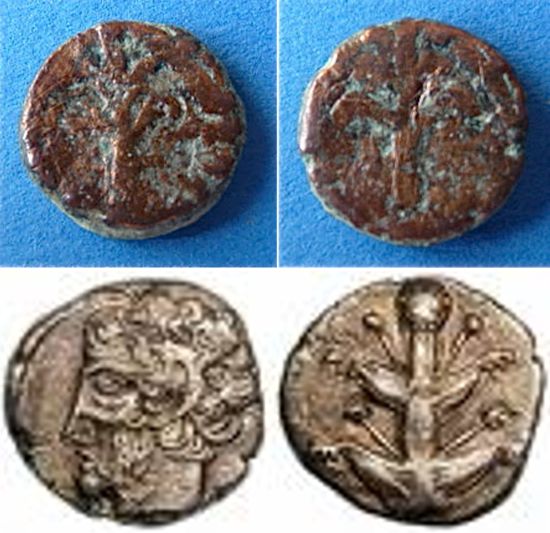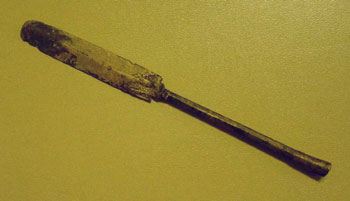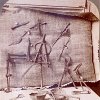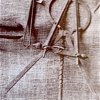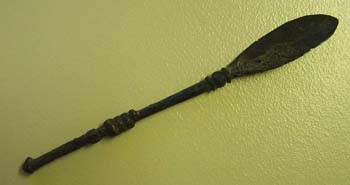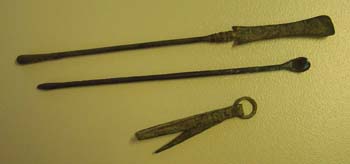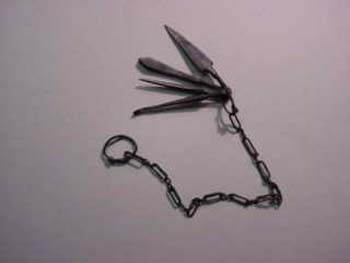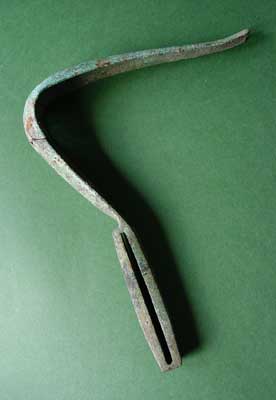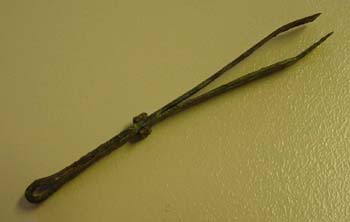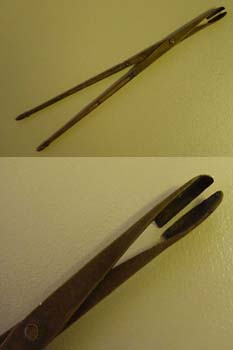Antique Medicine |
||
Scalpel (1) |
||
This scalpel found on the southern coast of England, has its edge preserved - whitch is rather rare: the iron is mostly gone with rust ...l |
Antique medicine |
||
Sewing needles |
||
IIn the Roman army we find the first approaches of a militaryity industry. Under Emperors Augustus (63 before 14 to Christ), the first time injured the legions were taken to the perfect time, with the aim of perfecting their professional knowledge, and thus the burden of the views can increase in higher ranks of the military hierarchy. The organization of the militaryity industry was, however, the heterstick structure, in the very time for the time at the time. As incentive to doctors for the little lucrative military service, from the Rome, the possibility of paid training was already created: the doctor as "immunis" (frozen, h. Of stone cocks or construction work). After training, the survey was led in the officer's rank. The working conditions of military doctors were quite good - in fortified stored stands were a separate building, the "valetudinarium", where injured and diseased soldiers of service-stroke soldiers could be separated. To the wound supply at Celsus we find the detailed description of a condom in the field of several layers:
Ligatures were carried out by Galen and also Orebasius (325-995 AD) with strong diagonic threads (Teubner Op.cit). As already Celsus (1st year ago, galen also emphasized the need to use a thread from non-slight material for vascular luminaires (Errerdt E., which is used in the surgery, the seams and nodes in historical representation. Collection of clinical lectures 1910, 580/581: 175-213) "(Monika Franziska Maria Flury, the development of surgical suture material as a prerequisite and sequetra- surgical activities and scientific research, District Würzburg 2002 p. 6). To the ancient needles Some needles are clearly surrenderly as a surgery: The multifunctionality is a characteristic feature of the craftsmanship of the Roman doctor, which is made of a dimensional heights, one is the one here the one-way of the here is one-way, one of the end of the end of a spoon (diameter 5 mm).
Length of the Needles: upper needle 122 mm lower needle 111 m.
Antique instrument bodies 120 mm Lower 115 mm antique instrument boxes The scalpel, bone lifts, needles and hooks in the (s), bone lifts, needles and hooks were in the case, bone lifts, needles and hooks in the (s), bone lifts, needles and hooks were in the case, bone lifts, needles and hooks in the (s), bone lifts, needles and hooks were in the case, bone lifts, needles and hooks in the (s), bone lifts, needles and hooks were in the case of bone lifts, needles and hooks in the (s), bone lifts, needles and hooks were in the case, bone lifts, needles and hooks in the (s), bone lifts, needles and hooks were in the case, bone lifts, needles and hooks in the (s), bone lifts, needles and hooks were in the case, bone lifts, needles and hooks in the (s), bone lifts, needles and hooks were in the case, bone lifts, needles and hooks in the (s), bone lifts, needles and hooks were in the case, bone lifts, needles and hooks in the (s), bone lifts, needles and hooks were in the case, bone lifts, needles and hooks in the (s), bone lifts, needles and hooks were in the case, bone lifts, needles and hooks in the (s), bone lifts, needles and hooks were in the case, bone lifts, needles and hooks in the (s), bone lifts, needles and hooks were in the case, bone lifts, needles and hooks in the (s), bone lifts, needles and hooks were in the case of bone, buttons and hooks in the case, bone lifts, needles and hooks were in the case, bone lifts, Testimony of the Grübsteine e.g. From the Asklepion of Athens or the Grave Crime for the doctor P. Aelius Pius Curtianus in Praeneste / Palastrina.
Rare, even pliers have been stored so. But leather roles were found that have served to transport instruments. |
Antique medicine |
||
Silphium, a contraceptive plant |
||
In Antiquity the Kyrenaika was populated by Berbers, the Libya, who several times attacked Egypt in the 10th century. Odyssos should be stranded here with his friends. The famous historian Herodot (about 480-420 BC) reports how the citizens of thera remind what the founding of their colony of Cyrene in Libya. From these Greeks colonies, significant cities developed: Kyrene was founded as a Greek colony of Alt-Thera on the Cyclades Island Santorin, and how was transferred to 630 v. Chr. From Aristotle to Thera ruled. Soon, the Greek Cyrene secondary branches in Bark, Euhesperides and Daucheira, and with their Greek cultural, cultivated the appearance of this area almost 1200 years. After Kyrene had succeeded in the Persian attacks under the battities, the monarchy was 440 v. Chr. With the Libyan residents of the area, Kyrene joined a states of the state, at his tip, a king (Battos). The Kyrenaika became the 4th century V. Chr. Part of the Ptolemeal. After the fall of the Persian, renamed, the Kyrenees founded the covert of five states under the protection of Egyptian Ptolemese 321. 117 Ward Kyrenaika converted into a kingdom under a disciples of branches of the Ptolemical Royal Family. 96 v. As Cyrenaica under the rule of Rome and Durden 74 v. Chr. Roman province. The country was unusual fertilitous. brought oil, figs, dates, almonds, wine, cucumbers, truffles, wheat, fragrant flowers; Also, cattle, bes. Horses, astrings, bees, but also devastating grasshoppers in the oppression.
The classic exporting articles were part of the V.Chr since the 6th century. The spice and medicinal plant Silphium. Silphium Silphium (Ital Silfio) grew only in the Kyrenaaica, in a country belt, which started from 30 miles from the sea, was 30 miles in the country and was 250 miles long. Silphium grew solely on this belt, since, according to Greek writers, in 617 BC. The floor in the area of the gardens of the heperidas and the big syrto suddenly beaten by a peel black. The effect of this rain is intended to have over 4000 stadiums. The silphium could not cultivate otherwise notes otherwise, it had endemed in Kyrenaica. The root had been more than ellenang, and just over the earth, a tanner was found. This tailor should, if you have acknowledged it, a milky juice that is easily released in saliva. The stem who grew up was called "Magydaris". The leaves of the silhphon, which were also the same seeds (?), Fell in the early street of the dog star - mid to the end of summer. The leaf carrot was in the Roman cuisine as a spice. Within a year, the plant had been grown. Heart shaped fruit "Phyllon". From the yellow petals, perfume was produced, the leaves served as a kitchen spice. As the leaves of the plant tasted, we can not say so; After her extinction, silhphon was replaced by the Persian asian or stinkasant, which today is considered a characteristic violence in India and has a luggage, highly dose sensitive penalt aromatic. In the modern playback of antique recipes, silphium is usually equated with the stinkasant functionlessly. Medical but estimated the resin, which was won by strikes from the root or the stem, the "opo". In the Altgriechian, the word "opos" did not defense any plant juice - and, again, finds out in the word "opium". This "opo" gained from the roots was the special remedy. The extraction of the "OPOS" was similar to today at ASA Foetida, by cutting the strong root and the exiting rubber resin-containing milk juice after the drying, was collected, collected, kneaded and packed for the export.
Silphium juice was used in different compositions and preparations, including a hair growth, lepramittic, in coughing, sod burn, fever, digestiveness, polleins, epilepsy and pain. Locally, he was applied to chickening eyes and other revices and burned her away (CF. "Wolfmilch" Euphorbium). At women, he brought the menstruation into gang and helped to follow the downhill. Silphium juice was considered a natural contraceptive, probably because of an estrogen-like vegetable drug, a phytooestrogen. For this purpose, one used a drink from the leaves of the plant, in wine "residual" OPOS "or with juice pedestrian vocalow ... SORANUS OF EPHESUS, who practiced in the Raeans (98-117) and Hadrian (117 - 138) in Rome, the weekly acknowledged the premises of the premises of the premises of the premises of the premises and a certainly the juice of the" OPOS ", which was the" opo "is defeated, the plant was already as extincted ... Obviously, he worked with a" replacement ", which was made of stinkasant and imported from Persia and Armenia to Rome. Modernial investigations have shown that plants of the same family (ASA Foetida) act as a reliable nationizer as a "pill after it" by blocking the progesterone production. Dioscorides (40-90 NC.) And Galen (129-199 NC.)
Recommended as the antibonic concept of the pomegranate. Today, today knows that in the cores of the pomegranate estrogen in high concentrations is located. All these agents explain how it described the Romans in the first 5 centuries of our time-announcement, to limit their family to 1-2 children ... At the beginning, the silphium was still a rather of women used and controlled medicine. The demand for the silhmoon gradually rose to the immense, and finally it was even bearily silted with silver denominations. Due to the great demand, the silhphon was harvested. From candidate, the powers of the country, on which the Silphium grew, grew her cattle to catch the stocks and thus the price to increase height. Climate change was increasingly becoming the area in which the silphium grew up to the desert. Which of these reasons was decisive, be there. The fact is that the herb finally stopping: the last found silphium plant should be sent to Emperor Nero, which is known to be 54-68 A. Chriser. The former meaning of the silhouette for the Kyrenic European can be read out that the silphium or parts thereof was shown to almost all Kyrenic acids. Exhibited is a 14 mm, 3.1 g of heavy, bronze coin from kyrene, with both sides (!) Of a silhmith plant - a coin (misary?) From the time of the independent kingdom, since during the Roman crew of the country of the classic provincial stylus with Avers prevails the Emperor profile. The conservation state of the coin presented here is unprecedented. Nevertheless, I prefer a bad original of a pike fence: for the better recognition of the plant including the sketch of a good-shaped coin with an imperial head and silhium. Origin of the coin: Private collection in Issaquah, Washington District, USA. |
Antique medicine |
||
Spatula probe |
||
|
Antique medicine |
||
Speculum from Pompei |
||
Underwood & Underwood was founded in 1881 in Ottawa, Kansas, by the brothers Elmer Underwood and Bert Elias Underwood. In 1887, the flourishing company moved to New York. In 1895 the company made several recordings in Italy, i.a. one in the Museum of Naples, where the artefacts from the "surgeon's house" from Pompeii were kept and exhibited. While all the photographs in historical books are two-dimensional, Underwood's photographs convey a three-dimensional view of the objects - they appear "within reach".
|
Antique medicine |
||
Spoon probe |
||
"The spoon probe is a multipurpose instrument that has not only found application in the field of medicine. The actual spoon is slim and narrow, the shape either semicircular or V-shaped. The other side may be, for example, a needle that can be used to sense foreign objects, but also olive-like thickening that could be used, for example, to burn out wounds. Between the two ends is a more or less long narrow handle whose transitions could have been decorated.
|
Antique medicine |
||
Toiletry items (1) |
||
Bronze cutlery consisting of a scraper (length 184 mm) (2), an ear spoon (length 156 mm) (3) and a small nail accessory (4). (*)
|
Antique medicine |
||
Toiletry items (2) |
||
In the year 16 BC the Romans founded the city of Augusta Treverorum, today's Trier. In the second half of the third century Trier became a bishop. From 271 to 274 the city was the residence of the Gallo-Roman counter-emperor Tetricus I. In 286 AD. The Roman Empire fell into two parts, Trier became imperial residence for the Western Empire under Emperor Maximilianus. As a result of this revaluation began in Trier a brisk building activity, which was continued under Emperor Constantius Chlorus and reached its peak under Emperor Constantine. Et al several spas were built:
The purifying body bath belonged to the Roman everyday life. Then as now, black fingernails were considered a proof of lack of personal hygiene. Mourning margins under the nails testify to manual work. Since such was always regarded as a dishonor to people of rank, "clean" fingernails were from time immemorial an insignia of the higher social strata, "clean" nails were considered to be the sign of those who had achieved something: the intellectuals, clerics, etc .. Thus, we find appropriate instruments of cleaning to the utensils of the fine Romans who cared for their noble body in public bathing or in the private bath maintained.
|
Antique medicine |
||
Toilery items (3): Strigilis |
||
The most intimate connection between baths and ointments is always apparent from the writings of the ancient physicians. They affect the healthy as well as the sick. The oils and ointments not only make the skin supple and give it substance. Rather, the body also absorbs the flavors and other things through the skin. It seems ancient times knew about it. ..
In both rooms, the bather could resort to the help of medically trained staff:
Lit. : |
Antique medicine |
|||
Toothpick |
|||
Literatur: Hans Sachs, Der Zahnstocher und seine Geschichte. Eine kulturgeschichtlich-kunstgewerbliche Studie (Reihe: Kulturgeschichte der Zahnheilkunde in Einzeldarstellungen, Band 1, 62 S Orig.Leinen kl4°; mit 87 Abbildungen und 1 Tafel, Berlin 1913
Hirschfelder, Gunther, Europäische Esskultur. Geschichte der Ernährung von der Steinzeit bis Heute. 2001, 327 S. ISBN: 3593368153 |
Antique medicine |
||
Pinzette |
||
|
Antique medicine |
||
Uvula forceps |
||
The uvula forceps was developed for the amputation of the uvula. This procedure was described by Aetius in the first half of the 6th century: before the suppository was cut off, it was extended by means of said pliers.
- 5 tweezers
Lit.: (*) M. Tabanelli, Lo strumento chirurgico e la sua storia, 1958. (**) E. Künzl, Medizinische Instrumente aus Sepulkralfunden der römischen Kaiserzeit, 2. Aufl 1983 S.74 (***) Th. Meyer-Steineg und Sudhoff, Geschichte der Medizin im Überblick mit Abb. 1922, S. 37.
|






